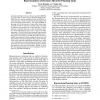Free Online Productivity Tools
i2Speak
i2Symbol
i2OCR
iTex2Img
iWeb2Print
iWeb2Shot
i2Type
iPdf2Split
iPdf2Merge
i2Bopomofo
i2Arabic
i2Style
i2Image
i2PDF
iLatex2Rtf
Sci2ools
AIPS
2000
2000
Representations of Decision-Theoretic Planning Tasks
Goal-directed Markov Decision Process models (GDMDPs) are good models for many decision-theoretic planning tasks. They have been used in conjunction with two different reward structures, namely the goal-reward representation and the action-penalty representation. We apply GDMDPs to planning tasks in the presence of traps such as steep slopes for outdoor robots or staircases for indoor robots, and study the differences between the two reward structures. In these situations, achieving the goal is often the primary objective while minimizing the travel time is only of secondary importance. We show that the action-penalty representation withoutdiscounting guaranteesthatthe optimalplan achieves the goal for sure (if this is possible) but neither the actionpenalty representation with discounting nor the goal-reward representation with discounting have this property. We then show exactly when this trapping phenomenon occurs, using a novel interpretation for discounting, namely that it models...
Action-penalty Representation | AIPS 2000 | Artificial Intelligence | Goal-reward Representation | Reward Structures |
| Added | 01 Nov 2010 |
| Updated | 01 Nov 2010 |
| Type | Conference |
| Year | 2000 |
| Where | AIPS |
| Authors | Sven Koenig, Yaxin Liu |
Comments (0)

